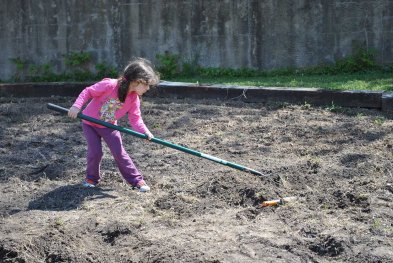This past Saturday temperatures in Memphis were in the upper 90s to insure a pretty light turn out for our regular Volunteer Day activities at the C.H. Nash Museum at Chucalissa – especially since we advertised a focus for the month on outdoor landscaping and gardening. In the end, we had a great day.

First, Rachel Clark from my Applied Archaeology and Museums class this past semester had proposed that we install a butterfly garden in the area that in Chucalissa’s pre-NAGPRA days housed the display of human remains excavated from the site. Over the past few weeks Rachel and I discussed the sensitive logistics for the proposed installation. The garden could not intrude below the ground surface in any way, given the very real possibility of remaining human burials in the vicinity. We also discussed installing a panel on a nearby kiosk to explain why the human burials were no longer exhibited at Chucalissa. A butterfly garden and informational display on the importance of NAGPRA and respecting the lives of those who built the 1000 year-old Native American earthwork complex seemed fitting and in line with the wishes of site development expressed by contemporary Native Americans of the Midsouth.
Second, on Saturday we also made arrangements for an Eagle Scout Project that will replace a dilapidated bridge along our nature trail. Eagle Scout projects are always a negotiated process, matching our museums’ needs with the ability, interest, and motivation of the individual Scout in tandem with Eagle project criteria. The bridge was in desperate need of replacement and the Scout chose the project from a half-dozen possibilities.

Third, on Saturday members of the Westwood Neighborhood Association were out to tend the urban garden they planted for the third consecutive year. The idea for the garden came from an offhand comment by a community member during a focus group on exhibit hall upgrades for our museum. One community member, the recently deceased Mr. Ralph Thompson, noted that the prehistoric agriculture exhibit at Chucalissa reminded him of traditional foods grown in his youth. He lamented the lack of a suitable public space for such a garden today. We immediately noted that we had 40 acres of protected space to consider for an urban garden, and the project took off. The garden is a source of pride for many community members. The participants this past Saturday, Mr. Robert Gurley and Rev. George Royal told me about how good it is for the body and soul just to get out in the sun and do physical labor. The urban garden produced a bountiful harvest in the past two years shared throughout the community.

Fourth, I was itching to spend the day out in the heat and humidity. I am one of those folks where the temperature and humidity never get too high. I spent the morning weeding in our Three Sisters garden, planted in individual hills typical of Native American cultures in the late prehistoric period. The plan for the garden was originally designed by Carrie Havrilla as a Green Internship project at the University of Memphis. This year we planted the garden as an April Earth Day activity with community members and families taking responsibility for individual hills. Fifteen students from Freedom Prep Academy, a local charter school, also participated in sculpting the hills and planting the corn, beans, and squash.

On Saturday afternoon I looked out on the open space of the prehistoric earthwork complex and thought about the three new gardens and bridge replacement. None of the projects were part of our strategic plan except that we seek to be an institution that is relevant to community needs and provides co-creative experiences. In all four of the projects the “public” whether Boy Scouts, students of all ages, or community members are creating projects of their choosing in a space that is publicly owned and administered. All of the projects fall well within the scope of our institutional mission and the expressed interests of our community stakeholders. I reflected how this co-creation process is messy, nonlinear, but highly relevant to expressed community interests. The process also flows directly from one of my favorite quotes in the New Museum by John Cotton Dana, written nearly 100 years ago: “Learn what aid the community needs: fit the museum to those needs.”




